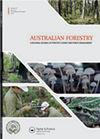入侵澳大利亚的厚壳木种群的季节飞行和遗传差异
IF 0.9
4区 农林科学
Q3 FORESTRY
引用次数: 1
摘要
摘要:厚脊木是一种入侵亚洲的安布罗西亚甲虫,已在世界多个地区传播,包括2011年在澳大利亚昆士兰和2019年在新西兰的首次记录。为了确定该物种在澳大利亚的季节性飞行活动,在新南威尔士州的三个研究地点放置了使用quercivorol+乙醇诱饵的面板诱捕器。这次诱捕产生了1173只甲虫,包括来自三个部落的21个物种(Xyleborini、Cryphalini和Hylurgini)。在12个月的时间里,粗糙木壳虫几乎占了捕获甲虫总数的一半,主要是由一个地点的捕获物驱动的。诱捕表明,粗尾X.在3月下旬和4月初达到季节性高峰。将澳大利亚和新西兰的粗尾X.标本与世界各地的其他种群之间的遗传关系进行了比较。对澳大利亚粗尾X.种群的系统发育分析表明,昆士兰的甲虫种群与新西兰和美洲国家的甲虫种群相似(Clade I),而新南威尔士州的甲虫种群则与东南亚种群密切相关(Clade II)。澳大利亚遗传种群的这种差异推断出粗尾X.是独立引入澳大利亚的。本文章由计算机程序翻译,如有差异,请以英文原文为准。
Seasonal flight and genetic distinction among Xylosandrus crassiusculus populations invasive in Australia
ABSTRACT Xylosandrus crassiusculus is an invasive Asian-origin ambrosia beetle that has spread across many regions of the world, including first records in Queensland, Australia, in 2011 and New Zealand in 2019. To determine the seasonal flight activity of this species in Australia, panel traps using quercivorol + ethanol lures were placed at three study sites in New South Wales. This trapping yielded 1173 beetles, consisting of 21 species from three tribes (Xyleborini, Cryphalini and Hylurgini). Xylosandrus crassiusculus contributed almost half the total number of beetles captured over a period of 12 months, mainly driven by catches at one site. The trapping showed a seasonal peak of X. crassiusculus in late March and early April. The genetic relationships between the Australian and New Zealand specimens of X. crassiusculus were compared with other populations across the world. Phylogenetic analysis of the Australian X. crassiusculus populations showed that the beetle population in Queensland was similar to those found in New Zealand and countries in the Americas (Clade I), while the New South Wales population was closely related to Southeast Asian populations (Clade II). This divergence of genetic populations in Australia infers independent introductions of X. crassiusculus into Australia.
求助全文
通过发布文献求助,成功后即可免费获取论文全文。
去求助
来源期刊

Australian Forestry
FORESTRY-
CiteScore
3.70
自引率
4.80%
发文量
15
审稿时长
>12 weeks
期刊介绍:
Australian Forestry is published by Taylor & Francis for the Institute of Foresters of Australia (IFA) for scientific, technical, and professional communication relating to forestry in the Asia Pacific.
 求助内容:
求助内容: 应助结果提醒方式:
应助结果提醒方式:


